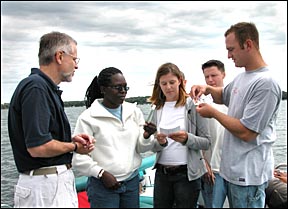|
|
|
|
|
July 25, 2003Lakeside lab promotes learning
Mike Barker maneuvers a pontoon carrying 10 Iowa State students away from the dock and toward the deepest part of Lake Okoboji. Barker, a graduate student in agronomy, is part of a watershed hydrology class held at the Iowa Lakeside Lab on West Okoboji. Earlier in the morning, students discussed the Rathbun watershed they had visited the day before. During this four-week course, students will study the characteristics of several Iowa watersheds, streams and lakes. Today, they are ready to learn more about Lake Okoboji. Their pontoon becomes a floating lab. Barker stops the boat in the middle of the lake and students begin to take measurements. One group uses a Secchi Disk, a flat steel disk with black and white markings, to measure water clarity. The process is simple; the disk is lowered into the water until the markings no longer are visible and then the rope is measured to get the depth of clarity. Other students measure the lake's pH, acidity and oxygen levels. The class is one of four Iowa State classes offered this summer at the Iowa Lakeside Lab, which is managed by the Board of Regents, State of Iowa. Agronomy associate professor Lee Burras teaches the hydrology class. "The first thing I ask students is, 'Do you know what watershed you grew up in?' And most don't," Burras said. A watershed is the area of land that drains into a stream or body of water. Burras said that knowing the boundaries of a watershed sometimes is more important than knowing political boundaries. "We are all downstream from someone. If you really want to understand what is going on with the water you use, you need to know your watershed boundaries," Burras said. After obtaining the measurements and recording data, the students return to shore for lunch. They eat meals together in a commons area overlooking the lake. Small class, big experience Tim Dougherty appreciates the small class size and the one-on-one attention from Burras. He also enjoys the outdoors and a chance to have this hands-on learning experience. He's a junior majoring in environmental science, and during the first few weeks of class, he has learned that there is a balance between economic and environmental issues. "It's much more complicated than, say, just planting a tree," Dougherty said. "If you plant a tree, you have to know who it will affect. Also, down the road, you need to know what type of resources the tree will need and where those resources come from." After lunch, the students travel five miles over gravel roads to Dugout Creek. The van stops just above a small stream that meanders through a flat, grassy area surrounded by hills. Students carry measuring instruments down a ditch, through waist-high grass, and wade into the stream to measure stream flow and water clarity. They also pull soil samples from beneath the grassy surface. After looking at the cylinders of black, organic soil, student Mary Nyasimi said, "This is gold." Nyasimi, from Kenya, is working on a master's degree in sustainable agriculture. She hopes to take what she learns back to Kenya and address water quality issues there. When asked about Kenya's water problems, Nyasimi sighs deeply. "One thing I can tell you is that women walk four hours to collect water," she said. Burras said one of the biggest advantages of the class for students is the hands-on learning experience. "I love teaching on campus, but I'm well aware that students may not know what a watershed is," he said. "Here, I'm confident they will remember what a watershed is for the rest of their lives." |
|
Ames, Iowa 50011, (515) 294-4111 Published by: University Relations, online@iastate.edu Copyright © 1995-2003, Iowa State University. All rights reserved. |
